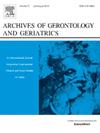The longitudinal relationship between intrinsic capacity, falls, and physical activity in Dutch older adults
IF 3.8
3区 医学
Q2 GERIATRICS & GERONTOLOGY
引用次数: 0
Abstract
Background
The relationship between intrinsic capacity (IC) and falls has not been studied in Western European older adults. This study aimed to examine the relationship between IC, falls, and physical activity (PA) in a Western European country, and to examine whether PA mediates the relation between IC and falls.
Methods
This study used data from community dwelling older adults from the Longitudinal Aging Study Amsterdam. Per participant, a baseline IC score was calculated (possible range 0–100). A Cox regression analysis (n = 1257) and a linear mixed model analysis (n = 1874) were used to examine the relation between IC and falls over a 3 year follow-up and between IC and PA over 3 and 6 years, respectively. A mediation analysis (n = 898) examined whether PA mediated the relation between IC and falls.
Results
Each one-point increase in IC score was associated with a 0.98 times lower 3-year fall hazard (95 % CI, 0.97–0.99). In older adults living in non-urban areas, those with the highest IC scores (range 71.7–92.5) spent on average 192 kcal/day more on PA (95 % CI, 127–256) than those with the lowest IC scores (range 26.5–63.0), while in older adults living in urban areas, those with the highest IC scores spent on average 89 kcal/day more on PA (95 % CI, 8–171). PA did not mediate the relationship between IC and falls.
Conclusion
Higher IC in older adults reduced fall risk and increased PA levels. Further research is needed on the acceptability and effectiveness of IC measurement in clinical practice.
荷兰老年人内在能力、跌倒和身体活动之间的纵向关系
背景:在西欧老年人中,尚未研究过内在能力(IC)与跌倒之间的关系。本研究旨在研究一个西欧国家的IC、跌倒和身体活动(PA)之间的关系,并研究PA是否在IC和跌倒之间的关系中起中介作用。方法本研究使用了来自阿姆斯特丹纵向老龄化研究的社区居住老年人的数据。每位参与者计算基线IC评分(可能范围0-100)。采用Cox回归分析(n = 1257)和线性混合模型分析(n = 1874)分别检验了IC与3年随访中跌倒之间的关系以及IC与3年和6年随访中PA之间的关系。一项中介分析(n = 898)检验了PA是否介导IC与跌倒之间的关系。结果IC评分每增加1分,3年跌倒风险降低0.98倍(95% CI, 0.97-0.99)。在生活在非城市地区的老年人中,IC得分最高的人(71.7-92.5)比IC得分最低的人(26.5-63.0)平均每天多花192千卡(95% CI, 127-256),而在生活在城市地区的老年人中,IC得分最高的人平均每天多花89千卡(95% CI, 8-171)。PA没有介导IC和跌倒之间的关系。结论:老年人较高的IC可降低跌倒风险并增加PA水平。在临床实践中,IC测量的可接受性和有效性有待进一步研究。
本文章由计算机程序翻译,如有差异,请以英文原文为准。
求助全文
约1分钟内获得全文
求助全文
来源期刊
CiteScore
7.30
自引率
5.00%
发文量
198
审稿时长
16 days
期刊介绍:
Archives of Gerontology and Geriatrics provides a medium for the publication of papers from the fields of experimental gerontology and clinical and social geriatrics. The principal aim of the journal is to facilitate the exchange of information between specialists in these three fields of gerontological research. Experimental papers dealing with the basic mechanisms of aging at molecular, cellular, tissue or organ levels will be published.
Clinical papers will be accepted if they provide sufficiently new information or are of fundamental importance for the knowledge of human aging. Purely descriptive clinical papers will be accepted only if the results permit further interpretation. Papers dealing with anti-aging pharmacological preparations in humans are welcome. Papers on the social aspects of geriatrics will be accepted if they are of general interest regarding the epidemiology of aging and the efficiency and working methods of the social organizations for the health care of the elderly.

 求助内容:
求助内容: 应助结果提醒方式:
应助结果提醒方式:


